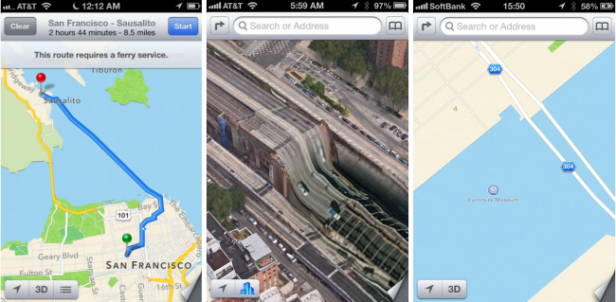ios6apocalypse: Maps May Drive Apple Round the Bend

 Let me run a sequence of numbers past you: eight, five, seven, seventeen and three. They are the number of updates Apple made to iOS before each significant upgrade. So for example v1.0 of iOS had eight updates before v2.0 was launched, v2.0 had five updates before v3.0 was launched, v3.0 had seven updates before v4.0 was launched and so on. The numbers are distorted at v4.0 because Apple added a CDMA-only version of the iPhone 4, but the long running GSM edition still received 11 updates. For iOS5 we got three updates in 12 months, two of them classed as security and bug fixes.
Let me run a sequence of numbers past you: eight, five, seven, seventeen and three. They are the number of updates Apple made to iOS before each significant upgrade. So for example v1.0 of iOS had eight updates before v2.0 was launched, v2.0 had five updates before v3.0 was launched, v3.0 had seven updates before v4.0 was launched and so on. The numbers are distorted at v4.0 because Apple added a CDMA-only version of the iPhone 4, but the long running GSM edition still received 11 updates. For iOS5 we got three updates in 12 months, two of them classed as security and bug fixes.
Read our full iPhone 5 review >
They provide evidence to a growing perception that Apple is not innovating anymore, that its class redefining mobile software is beginning to show its age and there is an increasing divide between the company’s hardware designers (obsessed with industrial minimalism) and its skeuomorphic-crazed software team determined to give everything fake leather, denim and paper finishes. This alone is claimed to be causing a significant rift within Apple. Superficiality aside, however, the problems run much deeper and – more worryingly – they are self inflicted.

Wrong Turn
We all know about the problems of iOS Maps: limited local business information, no public transport, occasionally baffling directions and the odd ill-informed geography lessons. They also feature many woefully distorted 3D images which spawned the ingenious Twitter hashtag #ios6apocalypse. Apple was predictably terse “We launched this new map service knowing it is a major initiative and that we are just getting started with it”. But it did not answer the bigger question: ”why start at all”?
Arguably Apple did not answer, because it is aware we all know: iOS Maps is not a solution to a problem customers needed fixing, it is a solution to a problem Apple wanted fixing. It’s name? Google. Apple’s strength is its homogeny, but it comes from being a paranoid control freak and ever since Google announced Android, Apple knew it could no longer rely on a market rival to supply core parts of its operating system long term.

Consequently Apple bought three mapping companies – Placebase, Poly9, and C3 Technologies – in three years, but in a most un-Apple-like twist it still has to rely on correlating data from no less than nine third parties: TomTom, Yelp, OpenStreetMap, Waze, Getchee, Localeze, Urban Mapping, DMTI and MapData Sciences. Yes Apple embarked upon one of the largest and most data complex projects imaginable and risked alienating huge chunks of its customer base because of self serving insecurity.


